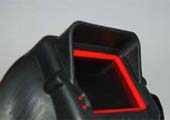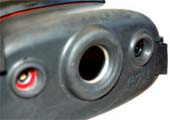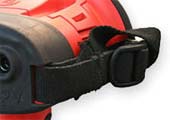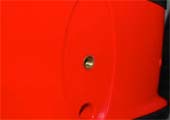Fire SuppressionArgus Thermal Imaging CamerasRugged Casing / Design DetailsPlasticsThe plastic chosen for the Argus4 is Radel-R5100, a very strong plastic composite. Radel R5100 was originally used on Argus 3’s. Argus moved away from polycarbonate because polycarbonate is not as strong as Radel. Radel also has special properties which enable it to limit the exposure to the internal components from external temperatures. It reduces the weight of the camera compared to polycarbonate and other competitive materials available. Front and Rear BumpersThe front and rear bumpers add additional protection to the camera if it is dropped. The user replaceable bumpers are made out of a material called “Multiflex”; an extremely high heat resistant and flame retardant material. 

The advantage of these heat resistant bumpers, over only having plastic molding at the front of the camera, is that it adds an extra protective layer if exposed to heat beyond the range of the camera, it provides a better grip, and provides additional impact protection. Side Straps
The Argus4 camera has 2 field replaceable side straps made out of Nomex®. They provide extra security for the user to be able to hold the camera securely and are adjustable to allow fitting to any sized gloved hand. HandleThe Argus4 camera is supplied with a handle to allow an additional method of holding onto the camera. It is easily fitted to the bottom of the camera and can be removed by simply turning the thumb wheel at the top of the handle. The handle is made of the same material as the camera (RadelR-5100) and over molded with Santoprene for improved grip and feel. The handle is designed to withstand the same drop tests as the camera when attached (6 feet / 2 meters). Tripod Mount
At the bottom of the camera is a standard 1/4 UNC screw thread that normally attaches to the handle. A tripod can be fitted to the camera using this screw thread if the handle is not fitted. This can be used for mounting the camera in a fixed position, if surveillance is required or for recording a department training exercise (with video recording option installed). WeightThe Argus 4 weighs less than 2.6 pounds (1.2kg) without the battery and the battery pack weighs less than 11oz (300g), to give a total camera weight of 3.3 lbs. (1.5kg). SealingThe camera is sealed to a standard called IP67 (Ingress Protection). All of these tests are performed by a third party compliance company. IP #6 tests dust ingress. Fine dust particles are blown at the camera to see if the camera is protected against dust ingress.When this test is completed the camera is disassembled to make certain that no dust appears inside the camera. If no dust is apparent, it achieves this classification. IP #7 tests water ingress. The camera is completely submerged in water to a depth of 3 ft. (1 meter) for 30 minutes. No water ingress should appear inside the camera. After the test the cameras are disassembled to make sure that water has not seeped into the camera. Sealing of the camera is very important. Cameras are used in various markets, such as fire departments, Coast Guard, etc... Proper sealing to avoid infiltration of water and dust is extremely critical to the reliability of the camera. The Argus camera is designed to float if dropped in water. ErgonomicsThe camera has been designed to allow multiple ways of holding the camera. It can be used as a one or two handed “binocular grip” and It can be used with one or two handles and with or without the straps. To enhance the use we also designed the handle to give the user additional flexibility. When not viewing, the camera sits comfortably at the side of the user as it is a flat camera design and not bulky. |
|
